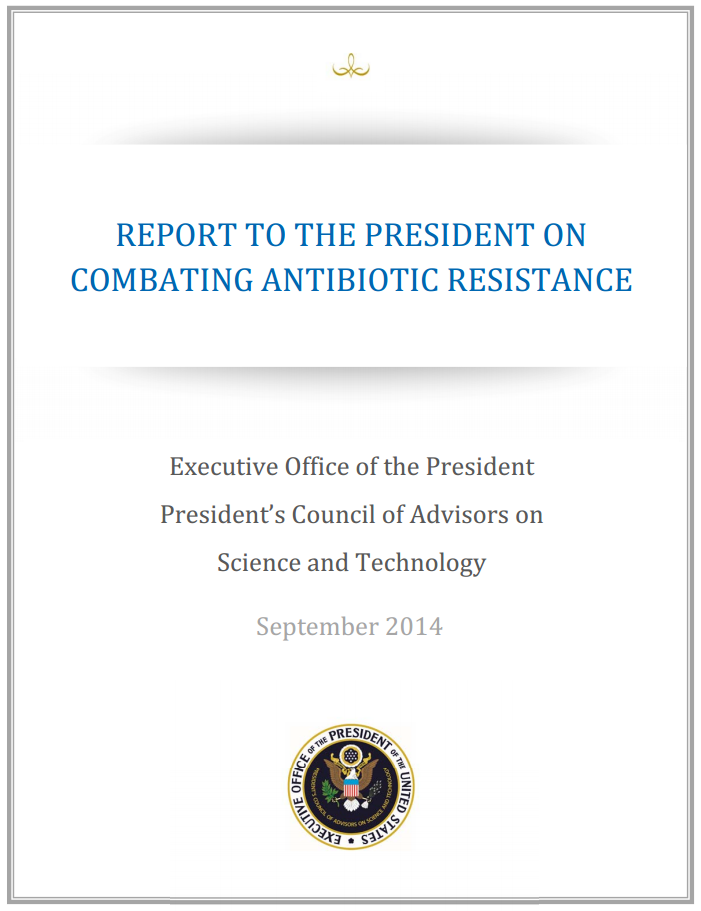How much do you know about antibiotic resistance? You might want to take the Pew Charitable Trust’s online quiz to find out. I’m embarrassed to say that I scored only 60%, despite my many years hanging around microbiologists. I got the biology questions right, but I didn’t know how many more days Americans spend in the hospital because of antibiotic resistant infections, nor how much antibiotic resistant infections cost our health care system. I would have done better on the quiz if I’d read  the report, Combating Antibiotic Resistance, that was just issued by the President’s Council of Advisors on Science and Technology (PCAST). The report not only explains the science behind antibiotic resistance, (hint: it has to do with evolution) but also lays out the societal and economic consequences.
the report, Combating Antibiotic Resistance, that was just issued by the President’s Council of Advisors on Science and Technology (PCAST). The report not only explains the science behind antibiotic resistance, (hint: it has to do with evolution) but also lays out the societal and economic consequences.
Along with PCAST’s report, the White House Office of Science and Technology Policy also released a National Strategy on Combating Antibiotic Resistant Bacteria, and an executive order calling for all the relevant federal agencies to work together to implement the strategy. Together, these documents lay out a comprehensive approach to dealing with what has grown from a more-or-less manageable problem to a full-blown crisis. Antibiotic resistant infections now cause 23,000 deaths per year in the United States alone; internationally, the problem is even greater. For example, extensively drug-resistant tuberculosis (XDR-TB) has been reported in 92 countries. XDR-TB is resistant to all standard anti-TB drugs, and one or more of the so-called “second-line” drugs, which are expensive and have more side effects. Not surprisingly, XDR-TB has a much higher mortality rate than non-drug-resistant TB.
Antibiotics have saved millions of lives, but the current crisis was foreseeable from their earliest use. The PCAST report quotes the warning that Alexander Fleming, discoverer of penicillin, included in his Nobel prize acceptance speech in 1945: “the danger that the ignorant man may easily underdose himself and by exposing his microbes to non-lethal qualities of the drug make them resistant.” Basic evolutionary principles would predict that applying a live-or-die selective pressure to a highly genetically variable target species would surely result in the emergence of resistant mutants. Broad-spectrum antibiotics–those that target many different kinds of bacteria–drive even more rapid emergence of antibiotic resistance because they act not only on the pathogen, but on all of the benign bacteria that live in and on our bodies. Since bacteria can easily share resistance genes, it doesn’t matter whether resistance develops first in the pathogen, or a harmless bystander species–it will soon spread.
Luckily, evolutionary principles should help us develop new antibiotics that avoid the pitfalls of the past. The answer will lie not in developing stronger and stronger antibiotics that kill all kinds of bacteria–we know where that leads. Instead, we can search for therapeutics that target specific pathogens, teamed with rapid diagnostics, or combination therapies that make it harder for resistance to evolve (like the ones described in my earlier posts: “Antibiotic Batman Finds His Robin: I and II”). Or we can try to develop therapeutics that aim not to kill, but to reduce pathogens’ virulence, or block their ability to communicate with each other. Other evolutionarily savvy approaches would be to take advantage of the ability of healthy communities of microbes to crowd out or inhibit pathogens, or utilize the exquisite specificity of bacteriophage (viruses that infect bacteria) to target a single bacterial species.
In short, evolutionary biology will be an essential tool in extending the useful lives of the antibiotics we already have, and in developing new ones to which resistance will emerge more slowly. In the meantime, in addition to greater investments in research on new antibiotics, the PCAST report calls for reducing overuse of antibiotics (in humans and animals), improving surveillance for antibiotic resistance, and developing rapid and specific diagnostic tests to identify drug-resistant infections.
The antibiotic-resistance crisis is real, and it could be coming to a hospital, locker room, or community health clinic near you. Indeed, it’s probably already there. Read the report, take the quiz, and make sure you understand why it’s so important to support national and international efforts to address the spread of antibiotic resistance.

